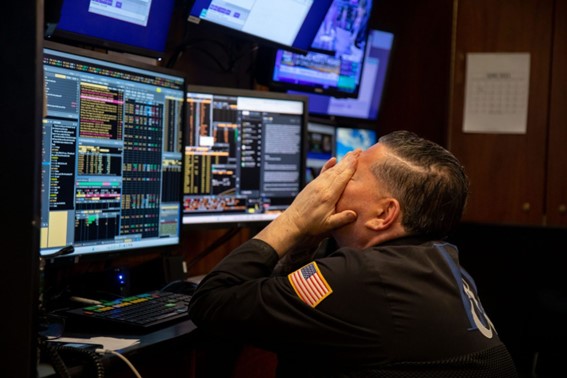
邁克·威爾遜(Mike Wilson)并不害怕在一個通常不會獎勵這種行為的行業中脫穎而出。2021年底,這位華爾街資深人士(現任摩根士丹利首席投資官和首席美國股票策略師)認為,在美聯儲加息和經濟增長放緩的雙重不利影響下,熊市即將來臨——他將二者稱為“火”與“冰”。
當時,華爾街的一致預測是,到2022年底,標準普爾500指數將上漲約1%,至4825點,但威爾遜的目標價是同行中最低的,為4400點,而熊市的情況是低于4000點。事實證明,這一悲觀預測是正確的,標準普爾500指數去年下跌了約20%,至3839點,威爾遜在《機構投資者》雜志(Institutional Investor)2022年10月的一項調查中獲得了頂級股票策略師的榮譽。
但2023年卻是另一番景象。
今年1月,這位摩根士丹利首席投資官認為,隨著企業盈利增長放緩,標準普爾500指數今年上半年可能會跌至3000點的低點,然后下半年才會回升至3900點。但該指數的表現卻恰恰相反,今年迄今為止,由于通脹緩慢消退,以及人們對人工智能作為未來企業增長的潛在驅動因素的熱情高漲,該指數上漲了超過12%,達到4300點以上。
不過,盡管其他投資銀行已經開始上調藍籌股指數的目標價,比如高盛集團(Goldman Sachs)現在預計標準普爾500指數今年將收于4500點,高于年初時的4000點,但威爾遜并沒有放棄熊市論調。
隨著標準普爾500指數反彈超過20%的閾值,越來越多的人宣布熊市正式結束。他在周一的一份報告中寫道:“我們尊重大家的觀點,但由于對2023年的盈利預測,我們持相反觀點。美國仍可能進入熊市。”
威爾遜的基本預測是,標準普爾500指數未來12個月將下跌約3%,至4200點,但在熊市情況下,他認為該指數可能跌至3700點,較當前水平下跌約14%。他認為,股市正處于一場“盈利衰退”之中,而且并未反映在股價中,華爾街的盈利預期過于強勁。
威爾遜周一寫道,華爾街對標準普爾500指數中超過70%的成分股的遠期盈利預期“至少比新冠肺炎疫情前的水平高出20%”,并指出,即使是摩根士丹利對整體指數的盈利預測——華爾街認為這一預測是看跌的——也“比長期盈利趨勢線高出10%”。
威爾遜熊市理論的關鍵在于,通脹下降將降低企業利潤,就像2021年通脹上升有助于增加企業利潤一樣。正如《財富》雜志此前報道的那樣,企業能夠在疫情期間轉嫁不斷上升的成本,提高利潤率。但現在,隨著通脹下降和經濟增長放緩,我們正進入“利潤率壓縮”的固有周期。
商業情報公司Morning Consult的首席經濟學家約翰·萊爾(John Leer)解釋說:“驅動利潤上升和下降的因素是相同的。已實現的和預期的需求都有所減弱;已實現的和預期的通脹都有所放緩;企業將無法把上漲的成本轉嫁給消費者。”
威爾遜周一還表示,高利率正導致經濟進入類似二戰后的“繁榮/蕭條模式”。他解釋說,在第二次世界大戰和大流行期間,消費者在商品和服務供應受限時期積累了過多儲蓄,導致經濟重新開放時通貨膨脹和股市飆升。隨后,在一段時間內,利率不斷上升,最終引發了1948年的熊市和經濟衰退。但在經濟陷入衰退之前,曾出現過一次大規模的熊市反彈,吸引了許多投資者。威爾遜擔心,現代投資者正再次落入同樣的陷阱。
戰后1946年的繁榮過后,標準普爾500指數修正了28%,隨后是一輪動蕩的熊市反彈(反彈24%,持續了近18個月),一年后跌至新低。到目前為止,這似乎與當前的熊市情況類似,去年股市修正了27.5%,目前已從盤中低點反彈了24%。”他寫道。他認為股市投資者可能會面臨更多痛苦。(財富中文網)
譯者:中慧言-王芳
邁克·威爾遜(Mike Wilson)并不害怕在一個通常不會獎勵這種行為的行業中脫穎而出。2021年底,這位華爾街資深人士(現任摩根士丹利首席投資官和首席美國股票策略師)認為,在美聯儲加息和經濟增長放緩的雙重不利影響下,熊市即將來臨——他將二者稱為“火”與“冰”。
當時,華爾街的一致預測是,到2022年底,標準普爾500指數將上漲約1%,至4825點,但威爾遜的目標價是同行中最低的,為4400點,而熊市的情況是低于4000點。事實證明,這一悲觀預測是正確的,標準普爾500指數去年下跌了約20%,至3839點,威爾遜在《機構投資者》雜志(Institutional Investor)2022年10月的一項調查中獲得了頂級股票策略師的榮譽。
但2023年卻是另一番景象。
今年1月,這位摩根士丹利首席投資官認為,隨著企業盈利增長放緩,標準普爾500指數今年上半年可能會跌至3000點的低點,然后下半年才會回升至3900點。但該指數的表現卻恰恰相反,今年迄今為止,由于通脹緩慢消退,以及人們對人工智能作為未來企業增長的潛在驅動因素的熱情高漲,該指數上漲了超過12%,達到4300點以上。
不過,盡管其他投資銀行已經開始上調藍籌股指數的目標價,比如高盛集團(Goldman Sachs)現在預計標準普爾500指數今年將收于4500點,高于年初時的4000點,但威爾遜并沒有放棄熊市論調。
隨著標準普爾500指數反彈超過20%的閾值,越來越多的人宣布熊市正式結束。他在周一的一份報告中寫道:“我們尊重大家的觀點,但由于對2023年的盈利預測,我們持相反觀點。美國仍可能進入熊市。”
威爾遜的基本預測是,標準普爾500指數未來12個月將下跌約3%,至4200點,但在熊市情況下,他認為該指數可能跌至3700點,較當前水平下跌約14%。他認為,股市正處于一場“盈利衰退”之中,而且并未反映在股價中,華爾街的盈利預期過于強勁。
威爾遜周一寫道,華爾街對標準普爾500指數中超過70%的成分股的遠期盈利預期“至少比新冠肺炎疫情前的水平高出20%”,并指出,即使是摩根士丹利對整體指數的盈利預測——華爾街認為這一預測是看跌的——也“比長期盈利趨勢線高出10%”。
威爾遜熊市理論的關鍵在于,通脹下降將降低企業利潤,就像2021年通脹上升有助于增加企業利潤一樣。正如《財富》雜志此前報道的那樣,企業能夠在疫情期間轉嫁不斷上升的成本,提高利潤率。但現在,隨著通脹下降和經濟增長放緩,我們正進入“利潤率壓縮”的固有周期。
商業情報公司Morning Consult的首席經濟學家約翰·萊爾(John Leer)解釋說:“驅動利潤上升和下降的因素是相同的。已實現的和預期的需求都有所減弱;已實現的和預期的通脹都有所放緩;企業將無法把上漲的成本轉嫁給消費者。”
威爾遜周一還表示,高利率正導致經濟進入類似二戰后的“繁榮/蕭條模式”。他解釋說,在第二次世界大戰和大流行期間,消費者在商品和服務供應受限時期積累了過多儲蓄,導致經濟重新開放時通貨膨脹和股市飆升。隨后,在一段時間內,利率不斷上升,最終引發了1948年的熊市和經濟衰退。但在經濟陷入衰退之前,曾出現過一次大規模的熊市反彈,吸引了許多投資者。威爾遜擔心,現代投資者正再次落入同樣的陷阱。
戰后1946年的繁榮過后,標準普爾500指數修正了28%,隨后是一輪動蕩的熊市反彈(反彈24%,持續了近18個月),一年后跌至新低。到目前為止,這似乎與當前的熊市情況類似,去年股市修正了27.5%,目前已從盤中低點反彈了24%。”他寫道。他認為股市投資者可能會面臨更多痛苦。(財富中文網)
譯者:中慧言-王芳
Mike Wilson isn’t afraid to stand out from the crowd in an industry that doesn’t often reward that type of behavior. In late 2021, the Wall Street veteran, who is now Morgan Stanley’s chief investment officer and chief U.S. equity strategist, argued that a bear market was on the way amid the toxic combination of Federal Reserve interest rate hikes and slowing economic growth—which he labeled “fire” and “ice.”
At the time, the consensus forecast on Wall Street was for the S&P 500 to rise roughly 1% to 4,825 by the end of 2022, but Wilson’s price target was the lowest of his peers at 4,400, with a bear case of below 4,000. The pessimistic prediction turned out to be correct, as the S&P 500 slipped roughly 20% last year to 3,839, earning Wilson top stock strategist honors in an October 2022 survey by Institutional Investor.
But 2023 has been a different story.
In January, the Morgan Stanley CIO argued that the S&P 500 could drop as low as 3,000 in the first half of the year as corporate earnings growth slowed, before mounting a second half recovery to 3,900. But the index has done pretty much the opposite, rising more than 12% year to date to over 4,300 on the back of slowly fading inflation and enthusiasm for artificial intelligence as a potential driver of future corporate growth.
Still, even as other investment banks have begun to increase their price targets for the blue-chip index—Goldman Sachs, for example, now sees the S&P 500 ending the year at 4,500, up from 4,000 at the start of the year—Wilson isn’t backing down from his bear market thesis.
“With the S&P 500 rally now crossing the 20% threshold, more are declaring the bear market officially over. We respectfully disagree due to our 2023 earnings forecast,” he wrote in a Monday note. “The bear is still alive.”
Wilson’s base case is for the S&P 500 to drop roughly 3% over the next 12 months to 4,200, but in a bear case scenario, he believes the index could fall to 3,700, or around 14% from current levels. He argues that stocks are in the midst of an “earnings recession” that hasn’t been priced in, and Wall Street’s profit expectations are too robust.
More than 70% of S&P 500 sectors have forward earnings expectations from Wall Street that are “at least 20% above pre-COVID levels,” Wilson wrote Monday, noting that even Morgan Stanley’s earnings forecast for the overall index, which is seen as bearish on the Street, is “10% above the long-term earnings trend line.”
The key to Wilson’s bearish theory is the idea that falling inflation will lower corporate profits, just as rising inflation helped to increase them in 2021. As Fortune previously reported, businesses were able to pass on rising costs during the pandemic and increase profit margins. But now, with inflation falling and economic growth slowing, we’re entering a natural period of “margin compression.”
“That’s driven by the same things that made the profits go up, coming down,” explained John Leer, chief economist at business intelligence firm Morning Consult. “You’ve got weaker demand, realized and expected; you’ve got slower inflation, realized and expected; and less ability for businesses to pass along elevated costs to consumers.”
Wilson also argued on Monday that higher interest rates are leading the economy into a “boom/bust regime” like what was seen after World War II. He explained that during both WWII and the pandemic, consumers built up excess savings during a period when the supply of goods and services was constrained, causing inflation and the stock market to surge when the economy reopened. Then a period of higher interest rates followed, which ultimately sparked a bear market and a recession in 1948. But before the economy entered that recession, there was a sizable bear market rally that lured in many investors. Wilson fears modern investors are falling into this same trap again.
“After the boom in 1946 following the end of the war, the S&P 500 corrected by 28%, followed by a 24% choppy bear market rally that lasted almost 18 months before succumbing to new lows a year later. Thus far, this appears similar to the current bear market, which corrected 27.5% last year and has now rallied 24% from the intraday lows,” he wrote, arguing more pain is likely ahead for stock market investors.






